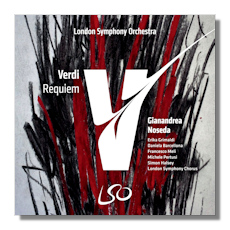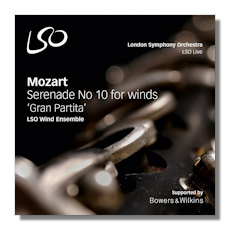
The Internet's Premier Classical Music Source
Related Links
-
Mozart Reviews
Verdi Reviews - Latest Reviews
- More Reviews
-
By Composer
-
Collections
DVD & Blu-ray
Books
Concert Reviews
Articles/Interviews
Software
Audio
Search Amazon
Recommended Links
Site News
 SACD Review
SACD Review
Giuseppe Verdi

Requiem
- Erika Grimaldi, soprano
- Daniela Barcellona, mezzo-soprano
- Francesco Meli, tenor
- Michele Pertusi, bass
London Symphony Chorus and Orchestra/Gianandrea Noseda
Simon Halsey, chorus director
Recorded Live at Barbican Centre, London September 18 & 20, 2016
LSO Live SACD LSO0800 77:55

Wolfgang Mozart

Serenade #10 for Winds in B Flat Major "Gran Partita", K. 361
LSO Wind Ensemble
Recorded live at St. Luke's, London, October, 2015
LSO Live SACD LSO5075 47:43
Here are two rather splendid SACDs from LSO, the in-house label of the London Symphony Orchestra. As the reader can observe from the headings, both contain live performances in signature locations – Barbican Centre and LSO St. Luke's (the orchestra's education center and venue for hire). I draw attention to the recording sites because of their supposed acoustical differences: Barbican Centre has come under criticism for its sound properties by some, while LSO St. Luke's is generally viewed as acoustically quite fine. Well, in these recordings LSO offers vivid sonics on both discs, though the Barbican effort is not quite perfect in every respect as will be noted below.
The Verdi Requiem was derived from the season-opening concerts given by the London Symphony Orchestra, in September, 2016. The concerts also marked the first Gianandrea Noseda conducted in his new role of Principal Guest Conductor of the LSO. To be sure, he had conducted the orchestra many times previously; moreover, he has held or holds many important conducting posts across the globe. He has appeared regularly at the Metropolitan Opera since 2002, has been music director at the Teatro Regio Torino from 2007, serves as principal guest conductor of the National Symphony Orchestra (2017) and Israel Philharmonic Orchestra (2011). He has held other important posts and made over fifty recordings, many high acclaimed. I have given this brief biographical summary because, all things considered, I think this recording is more about Noseda than the others involved here.
It's not that the soloists, chorus and orchestra turn in less compelling work in the endeavor: indeed, all parties perform quite well, though no single contribution seems to stand out in what is nevertheless an extraordinary effort. This is a case where the sum of the unostentatious parts adds up to a magnificent whole. Soprano Erika Grimaldi sings with utter conviction throughout: try her thoroughly committed Requiem aeternam and Libera me at the end. Daniela Barcellona is just as convincing, especially in such numbers as Liber Scriptus. Tenor Francesco Meli is also quite fine, even when he goes a little overboard as with the Ingemisco. Michele Pertusi is perhaps a bit more consistent and has an appropriately humane and sincere sense: try his very compelling Mors stupebit and Confutatis.
But it is mainly the masterly shaping of the score by Noseda as well as the spirited performances he draws from the chorus and orchestra that make this recording such a fine success. With moderate to brisk tempos, a deft sense for dynamics and vocal balances, and a thoroughly unerring grasp on the emotional flow of the music, Noseda captures both the sacred and operatic sides of Verdi's Requiem. From the extremely hushed opening onto the utterly thrilling but unsettling Dies Irae and the intensity of the Tuba mirum, the Requiem begins in dramatic style. Throughout the work the tension and sense of distress never really let up, with the return of the frenzied Dies Irae leading to the hushed but passionate lugubriousness of the ensuing Requiem aeternam and then to the anxious and ultimately capitulating Libera me.
Sir Georg Solti made two excellent recordings of Verdi's Requiem with superstar casts, and Karajan made four, each also with an impressive cast. And, not surprisingly, there have been many other fine recordings of this great work. Thus, the competition is fierce – fierce but not unchallenged. This new SACD by Noseda is certainly among the most worthy challengers: most listeners will find it is a powerful and completely effective performance in almost every respect. I only wish the solo singers were miked a little more closely, but the sound reproduction is otherwise quite excellent. Full texts are given in multiple languages and highly informative notes by David Cairns round out this fine issue. One verdict only can be given here: strongly recommended!
As for the Mozart SACD… Mozart wanted this tenth serenade to be something quite special, grand really – hence the nickname Gran Partita. Typically, the scoring in his day for the type of ensemble used here involved six instruments: pairs of oboes, French horns and bassoons, and sometimes two clarinets. He not only included the clarinets for this new work but added two basset-horns, two extra French horns and a double bass. He also invested the composition with some of his finest music, and it has become perhaps his best known serenade, after the famous #13, Eine kleine Nachtmusik. Many listeners will recognize the Gran Partita's third movement music, as it was used in the movie Amadeus. Its main theme bears a strong resemblance to another of Mozart's famous melodies, the second movement theme from his Piano Concerto #21, which coincidentally was also used in a popular movie, Elvira Madigan.
In this performance the LSO Wind Ensemble play with great spirit and energy. The players obviously realize that while the serenade is "grand", it is mostly festive and light in mood and they fully convey the energy, joy and the sometimes serene character of the work. Their account of the third movement features not only a tempo that is to my ears perfect but phrasing that fully captures the mesmerizing nature of the music. They play the first movement's Largo introduction with a similar sense of serenity and go on to deliver the chipper Molto Allegro music in a lively but not rushed manner, wisely resisting the tendency to overplay the contrast between the two sections. The Menuetto fourth movement is elegant, witty and colorful, while the ensuing Romance is appropriately dreamy and relaxed in the outer sections and subtly mischievous and comical in the middle section. The players deftly capture the smorgasbord of ideas and moods in the lengthy theme-and-variations sixth movement, as well as in the jovial and robust celebrations in the brief finale.
As suggested above the sound reproduction is vivid and well balanced. The only drawback to this recording is its somewhat brief length of 47:43. Otherwise, it's a splendid offering all around.
Copyright © 2017, Robert Cummings


















